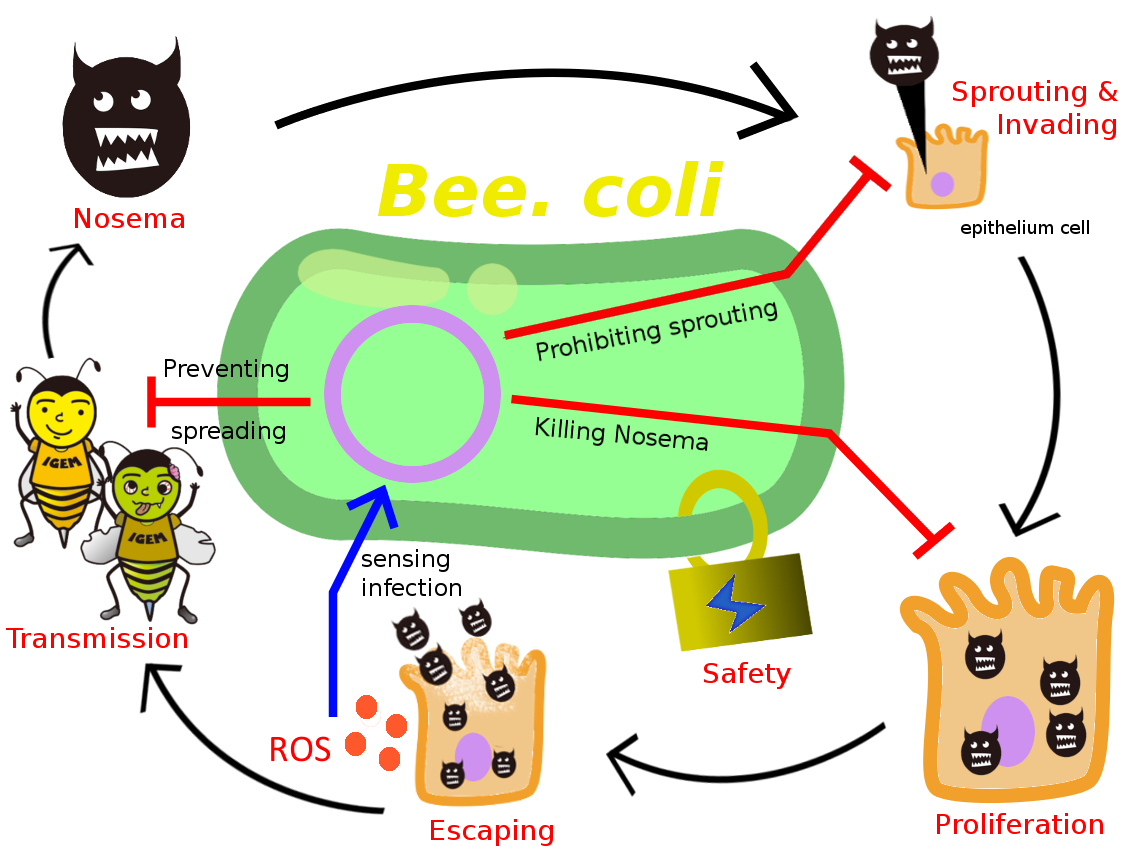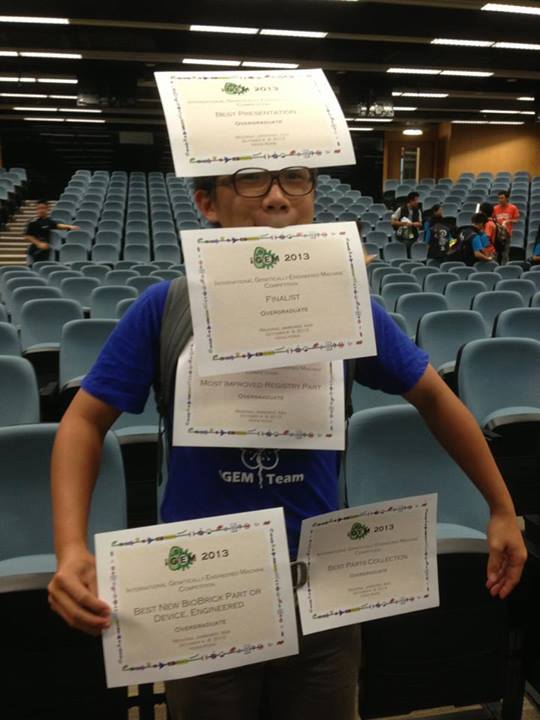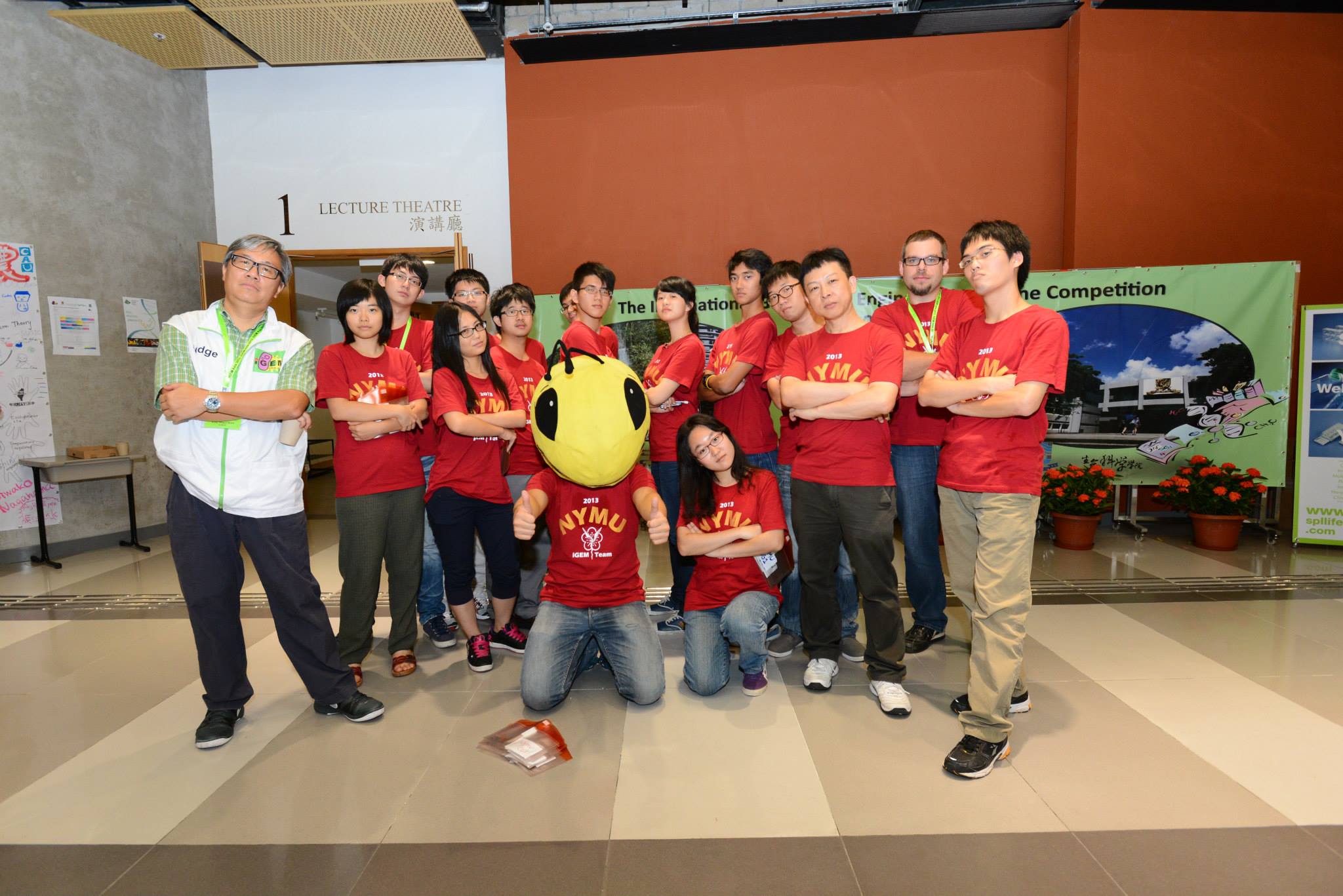Team:NYMU-Taipei
From 2013.igem.org
Mastershot (Talk | contribs) |
Mastershot (Talk | contribs) |
||
| (79 intermediate revisions not shown) | |||
| Line 1: | Line 1: | ||
| - | {{:Team:NYMU-Taipei/ | + | {{:Team:NYMU-Taipei/Frontpage}} |
| + | ==Overview of 2013 NYMU iGEM Team Project== | ||
| - | + | To save bees from ''Nosema ceranae'' infection, the culprit of colony collapse disorder (CCD), NYMU-Taipei iGEM team has created the so-called ''Bee. coli'' from ''Escherichia coli'' MG1655, which naturally resides in bees. The ''Bee. coli'' is designed to work successively as follows: (1) ''Bee. coli'' continuously secretes mannosidase to inhibit the sprouting of N. ceranae spores. (2) if the bee is infected with ''N. ceranae'', the fungus-killing-circuit with a positive feedback design will be turned on to wipe out ''N. ceranae''. (3) if these designer weapons should fail to conquer ''N. ceranae'', a bee-suicide-operon will be activated to kill the infected bees but save their companions. | |
| - | + | ||
| - | + | ||
| - | + | ||
| - | + | ||
| - | + | ||
| - | + | ||
| - | + | ||
| - | + | ||
| - | + | ||
| - | + | ||
| - | + | ||
| - | + | ||
| - | + | ||
| - | + | ||
| - | + | ||
| - | + | ||
| - | + | Besides, a light-inducible lysis system is created to ensure our ''Bee. coil'' only lives inside of the bee. In addition, we have used encapsulation as the method to send our ''Bee. coli'' into the bee. Since the capsule will only dissolve in a bee’s gut, our ''Bee. coli'' will not wantonly spread out. | |
| - | + | [[File:NYMU_project_overview.png|900px|center|link=https://2013.igem.org/Team:NYMU-Taipei/Project/Overview]] | |
| + | ==[https://2013.igem.org/Jamborees-Asia Our 2013 iGEM Awards]== | ||
| + | [[File:i'm the winner.png|right|200px]] | ||
| + | ===☆ Finalist=== | ||
| - | + | ===☆ 1st runner up=== | |
| + | |||
| + | ===☆ Best Presentation=== | ||
| + | |||
| + | ===☆ Best Parts Collection=== | ||
| + | |||
| + | ===☆ Most Improved Registry Part=== | ||
| + | |||
| + | ===☆ Best New BioBrick Part or Device, Engineered=== | ||
| + | |||
| + | [[File:NYMU_we're_the_winnner.png|800px|center]] | ||
| + | |||
| + | ==List of Our Experimental Accomplishments== | ||
| + | [https://2013.igem.org/Team:NYMU-Taipei/Experiment/Wet_Lab ✓ 23 new BioBricks to part registry] | ||
| + | |||
| + | [https://2013.igem.org/Team:NYMU-Taipei/Project/Enter ✓ A way to transport genetic modified ''E. coli''] | ||
| + | |||
| + | [https://2013.igem.org/Team:NYMU-Taipei/Project/safe ✓ A light-induced lysis system for safety] | ||
| + | |||
| + | [https://2013.igem.org/Team:NYMU-Taipei/Project/Inhibition/Sensor ✓ The improvement of BioBrick Part AhpCp] | ||
| + | |||
| + | [https://2013.igem.org/Team:NYMU-Taipei/Modeling/Overview ✓ Modeling standard for prescription of engineered ''E. coli''] | ||
| + | |||
| + | [https://2013.igem.org/Team:NYMU-Taipei/Modeling/Ethanol ✓ An inducible delay positive feedback circuit] | ||
| + | |||
| + | [https://2013.igem.org/Team:NYMU-Taipei/HumanPractice/HumCollab ✓ Help NTU-Taida iGEM team characterize their BioBrick devices] | ||
| + | |||
| + | [https://2013.igem.org/Team:NYMU-Taipei/HumanPractice/HumFlows ✓ Video documentations of performing experimental procedures] | ||
| + | |||
| + | [https://2013.igem.org/Team:NYMU-Taipei/HumanPractice/HumPracticalApp ✓ Cooperation with beekeepers] | ||
| + | |||
| + | [https://2013.igem.org/Team:NYMU-Taipei/Project/Inhibition/Id-Nosema ✓ Primers for identifying Nosema] | ||
| + | |||
| + | {{:Team:NYMU-Taipei/Frontpage/Footer}} | ||
Latest revision as of 02:41, 29 October 2013

Taipei, Taiwan


Contents |
Overview of 2013 NYMU iGEM Team Project
To save bees from Nosema ceranae infection, the culprit of colony collapse disorder (CCD), NYMU-Taipei iGEM team has created the so-called Bee. coli from Escherichia coli MG1655, which naturally resides in bees. The Bee. coli is designed to work successively as follows: (1) Bee. coli continuously secretes mannosidase to inhibit the sprouting of N. ceranae spores. (2) if the bee is infected with N. ceranae, the fungus-killing-circuit with a positive feedback design will be turned on to wipe out N. ceranae. (3) if these designer weapons should fail to conquer N. ceranae, a bee-suicide-operon will be activated to kill the infected bees but save their companions.
Besides, a light-inducible lysis system is created to ensure our Bee. coil only lives inside of the bee. In addition, we have used encapsulation as the method to send our Bee. coli into the bee. Since the capsule will only dissolve in a bee’s gut, our Bee. coli will not wantonly spread out.
Our 2013 iGEM Awards
☆ Finalist
☆ 1st runner up
☆ Best Presentation
☆ Best Parts Collection
☆ Most Improved Registry Part
☆ Best New BioBrick Part or Device, Engineered
List of Our Experimental Accomplishments
✓ 23 new BioBricks to part registry
✓ A way to transport genetic modified E. coli
✓ A light-induced lysis system for safety
✓ The improvement of BioBrick Part AhpCp
✓ Modeling standard for prescription of engineered E. coli
✓ An inducible delay positive feedback circuit
✓ Help NTU-Taida iGEM team characterize their BioBrick devices
✓ Video documentations of performing experimental procedures
 "
"






















